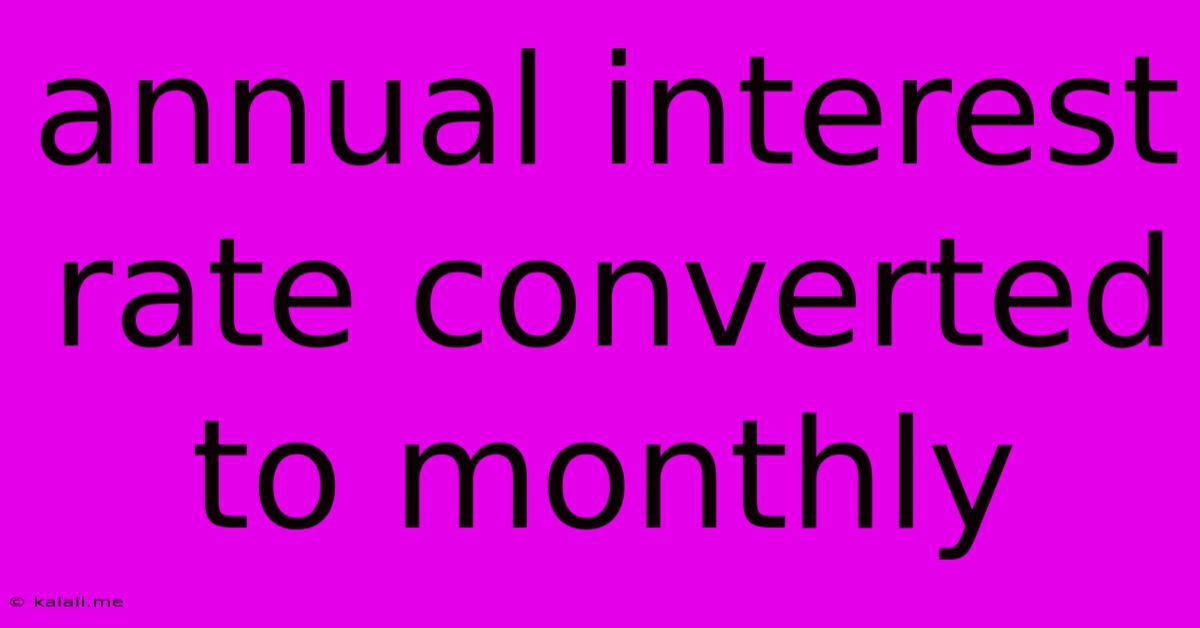Annual Interest Rate Converted To Monthly
Kalali
May 21, 2025 · 3 min read

Table of Contents
Understanding Annual Interest Rates and Their Monthly Equivalents
Knowing how to convert an annual interest rate to a monthly rate is crucial for anyone dealing with loans, investments, or savings accounts. This seemingly simple calculation has significant implications for understanding the true cost of borrowing or the potential return on your investments. This article will guide you through the process, explaining the underlying math and offering practical examples.
What is an Annual Interest Rate?
An annual interest rate represents the percentage of the principal amount you'll earn or pay in interest over a year. For example, a 6% annual interest rate on a $1,000 loan means you'll pay $60 in interest over the course of a year. However, interest is usually calculated and compounded more frequently – monthly, quarterly, or daily. Therefore, understanding the equivalent monthly rate is essential for accurate financial planning.
Converting Annual Interest Rate to Monthly Interest Rate
The conversion itself is relatively straightforward. It involves a simple formula based on the concept of compounding. The formula is:
Monthly Interest Rate = (1 + Annual Interest Rate)^(1/12) - 1
Where:
- Annual Interest Rate: This is your annual interest rate expressed as a decimal (e.g., 6% = 0.06).
- (1/12): This represents the 12 months in a year.
Let's illustrate this with an example:
Suppose you have a loan with a 12% annual interest rate. To find the monthly interest rate:
- Convert the annual rate to a decimal: 12% = 0.12
- Apply the formula: (1 + 0.12)^(1/12) - 1 ≈ 0.00948879
- Convert the result back to a percentage: 0.00948879 * 100% ≈ 0.95%
Therefore, a 12% annual interest rate is approximately equivalent to a 0.95% monthly interest rate. It's important to note that this is an approximate value due to rounding. Financial calculators or spreadsheets will often provide more precise results.
Why is this Conversion Important?
Converting annual interest rates to monthly rates is important for several reasons:
- Accurate Loan Calculations: Loan payments are typically calculated monthly, so using the monthly interest rate provides a more accurate representation of the total interest paid over the loan's term.
- Investment Returns: Similarly, understanding the monthly return on investments allows for better tracking of growth and a clearer picture of your overall investment performance.
- Comparison Shopping: When comparing loans or investment options, it's crucial to compare them on an equivalent basis. Converting to a monthly rate allows for a more direct comparison.
- Compounding Effects: Understanding the monthly rate helps you visualize the effect of compounding, where interest earned is added to the principal, leading to further interest accrual.
Using Technology for Calculation
While the formula is relatively simple, using a financial calculator or spreadsheet software (like Excel or Google Sheets) can simplify the process and ensure accuracy. These tools often have built-in functions specifically designed for interest rate conversions.
Conclusion:
Converting an annual interest rate to a monthly rate is a crucial skill for effective financial management. While the calculation is simple, understanding its implications for loans, investments, and overall financial planning is paramount. Using the provided formula or leveraging technology, you can accurately determine the monthly equivalent and make informed financial decisions. Remember to always double-check your calculations for accuracy.
Latest Posts
Latest Posts
-
Cmd Shift 4 Only Doing Lie Of Pixels
May 23, 2025
-
Blender 2 Vertex Appear Very Close
May 23, 2025
-
Cd With Buffer And Bit Correction
May 23, 2025
-
Ice Maker Solenoid Valve Fitting Size Dimensions
May 23, 2025
-
How To Type Schrodinger In Latex
May 23, 2025
Related Post
Thank you for visiting our website which covers about Annual Interest Rate Converted To Monthly . We hope the information provided has been useful to you. Feel free to contact us if you have any questions or need further assistance. See you next time and don't miss to bookmark.